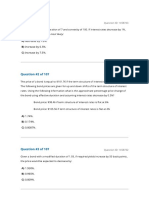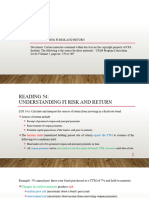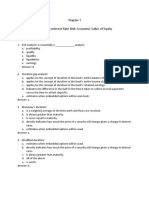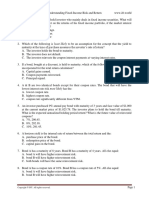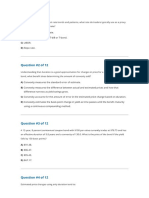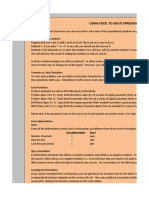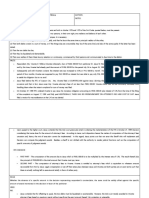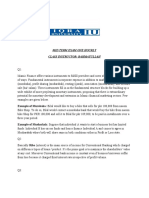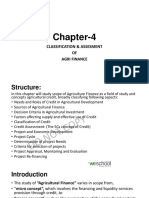Chapter Sixteen Test Bank
Chapter Sixteen Revision of the Fixed-Income Portfolio A a. b. c. d. A a. b. c. d. D a. b. c. d. C a. b. c. d. D a. b. c. d. A a. b. c. d. 1. Passive bond strategies include buy & hold, indexing constant beta, constant proportion constant duration, constant yield constant duration, constant convexity 2. Which of the following is usually least appropriate for a bond portfolio? Buy and hold Indexing Constant proportion Barbell strategy 3. The Handbook of Fixed Income Securities lists about _____ different bond indexes. 9 29 129 229 4. A well-known bond index is one published by Jackson, Brookings Donaldson, Lufkin, Jenrette Lehman Kuhn Loeb Josephthals 5. Which of the following is the principal characteristic of a laddered bond portfolio? Constant annual income Constant portfolio value No interest rate risk Equal proportions across the yield curve 6. Annual revision of a laddered bond portfolio requires buying a long-term bond selling a short-term bond selling a long-term bond buying a short-term bond
239
�Chapter Sixteen Test Bank
B a. b. c. d. D a. b. c. d. B a. b. c. d. B
7. The principal way in which a barbell portfolio differs from a laddered portfolio is the barbell has greater investment in the middle maturities less investment in the middle maturities greater investment in high coupon bonds greater investment in low coupon bonds 8. Which of the following is arbitrary in a barbell bond portfolio? Number of weights Size of the weights Thickness of the bar All of the above 9. If you pay commissions to buy or sell bonds, annual revision of a barbell portfolio requires the payment of ____ commissions. 2 3 4 6 10. If you hold yield to maturity constant and plot bond duration as a function of years until maturity, the curve has a _____ first derivative and a _____ second derivative. a. positive, positive b. positive, negative c. negative, positive d. negative, negative 11. Yield curve inversion occurs when a. short-term rates are rising faster than long-term rates b. long-term rates are rising faster than short-term rates c. short-term rates equal long-term rates d. T-bill rates are less than government bond rates 12. Which of the following types of swaps is inconsistent with the efficient market hypothesis? a. Substitution b. Intermarket c. Bond rating d. Rate anticipation
240
�Chapter Sixteen Test Bank
13. Convexity is the difference between a. actual price change and duration-predicted price change b. actual price change and market average price change c. actual price change and government bond price change d. actual price change and yield to maturity change 14. The importance of convexity increases as a. time passes b. the level of interest rates rises c. the level of interest rates falls d. the magnitude of the rate change increases 15. Convexity is related to the ____ derivative of the bond pricing relationship. a. first b. second c. third d. fourth 16. Modified duration is ______ Macaulay duration. a. equal to b. greater than c. less than d. greater than or equal to 17. Which of the following is false? a. The higher the yield to maturity, the lower the convexity, everything else being equal b. The lower the coupon, the greater the convexity, everything else being equal c. The greater the convexity, the better, everything else being equal d. The higher the duration, the lower the convexity, everything else being equal 18. Everything else being equal, bond investors prefer a. high convexity b. low convexity c. convexity equal to the bond market average d. none of the above
241
�Chapter Sixteen Test Bank
19. An appropriate comparison between the performance of a managed bond portfolio and an index requires finding an index with the same a. reinvestment rate risk and interest rate risk b. default risk and duration c. level of annual turnover d. average coupon rate and maturity 20. Assuming average coupon rates and a normal yield curve, the ladder portfolio generally has ________ reinvestment rate risk and _______ interest rate risk than a barbell portfolio. a. less, more b. less, less c. more, less d. more, more 21. When comparing the performance of ladder and barbell portfolios, if interest rates decrease, _______ portfolios are favored in terms of reinvestment rate risk and _______ portfolios are favored in terms of interest rate risk. a. ladder, ladder b. ladder, barbell c. barbell, ladder d. barbell, barbell 22. Suppose a bond has 20 years left to maturity, an 8% coupon rate, pays interest semi-annually, and has a 6% yield to maturity. If this bond has a Macaulay duration of 11.23 years and a convexity of 170.26, and the yield to maturity increases 1%, an estimate of the percent price change in the bond due only to duration would be a. 11.23% b. 10.90% c. 9.23% d. 8.23% 23. Suppose a bond has 20 years left to maturity, an 8% coupon rate, pays interest semi-annually, and has a 6% yield to maturity. If this bond has a Macaulay duration of 11.23 years and a convexity of 170.26, and the yield to maturity increases 1%, an estimate of the percent price change in the bond due only to convexity would be a. 0.85% b. 1.77% c. +0.85% d. +1.77% 24. Suppose a bond has 20 years left to maturity, an 8% coupon rate, pays interest semi-annually, and has a 6% yield to maturity. If this bond has a Macaulay duration
242
�Chapter Sixteen Test Bank
of 11.23 years and a convexity of 170.26, and the yield to maturity increases 1%, an estimate of the percent price change in the bond due to both duration and convexity would be a. 12.36% b. 11.44% c. 10.05% d. 8.82% B 25. Suppose a bond has 20 years left to maturity, an 8% coupon rate, pays interest semi-annually, and has a 6% yield to maturity. If this bond has a Macaulay duration of 11.23 years and a convexity of 170.26, and the yield to maturity decreases 1%, an estimate of the percent price change in the bond due only to duration would be a. 11.23% b. 10.90% c. 9.23% d. 8.23% 26. Suppose a bond has 20 years left to maturity, an 8% coupon rate, pays interest semi-annually, and has a 6% yield to maturity. If this bond has a Macaulay duration of 11.23 years and a convexity of 170.26, and the yield to maturity decreases 1%, an estimate of the percent price change in the bond due only to convexity would be a. 0.85% b. 1.77% c. 0.85% d. 1.77% 27. Suppose a bond has 20 years left to maturity, an 8% coupon rate, pays interest semi-annually, and has a 6% yield to maturity. If this bond has a Macaulay duration of 11.23 years and a convexity of 170.26, and the yield to maturity decreases 1%, an estimate of the percent price change in the bond due to both duration and convexity would be a. 12.93% b. 11.75% c. 10.59% d. 9.23%
28. Suppose a bond has 25 years left to maturity, a 5% coupon rate, pays interest semi-annually, and has a 7% yield to maturity. If this bond has a Macaulay duration of 13 years and a convexity of 237.15, and the yield to maturity increases 1/2%, an estimate of the percent price change in the bond due only to duration would be a. 6.50%
243
�Chapter Sixteen Test Bank
b. 6.28% c. 5.64% d. 5.21% C 29. Suppose a bond has 25 years left to maturity, a 5% coupon rate, pays interest semi-annually, and has a 7% yield to maturity. If this bond has a Macaulay duration of 13 years and a convexity of 237.15, and the yield to maturity increases 1/2%, an estimate of the percent price change in the bond due only to convexity would be a. 0.60% b. 0.30% c. +0.30% d. +0.60% 30. Suppose a bond has 25 years left to maturity, a 5% coupon rate, pays interest semi-annually, and has a 7% yield to maturity. If this bond has a Macaulay duration of 13 years and a convexity of 237.15, and the yield to maturity increases 1/2%, an estimate of the percent price change in the bond due to both duration and convexity would be a. 6.37% b. 6.21% c. 5.98% d. 5.61% 31. Suppose a bond has 25 years left to maturity, a 5% coupon rate, pays interest semi-annually, and has a 7% yield to maturity. If this bond has a Macaulay duration of 13 years and a convexity of 237.15, and the yield to maturity decreases 1/2%, an estimate of the percent price change in the bond due only to duration would be a. 5.21% b. 5.64% c. 6.28% d. 6.50%
32. Suppose a bond has 25 years left to maturity, a 5% coupon rate, pays interest semi-annually, and has a 7% yield to maturity. If this bond has a Macaulay duration of 13 years and a convexity of 237.15, and the yield to maturity decreases 1/2%, an estimate of the percent price change in the bond due only to convexity would be a. 0.60% b. 0.30% c. +0.30% d. +0.60%
244
�Chapter Sixteen Test Bank
33. Suppose a bond has 25 years left to maturity, a 5% coupon rate, pays interest semi-annually, and has a 7% yield to maturity. If this bond has a Macaulay duration of 13 years and a convexity of 237.15, and the yield to maturity decreases 1/2%, an estimate of the percent price change in the bond due to both duration and convexity would be a. 5.77% b. 6.20% c. 6.58% d. 6.87%
245



